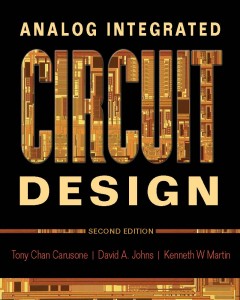Table of Contents

Chapter 1: Integrated Circuit Devices and Modelling
1.1 Semiconductors and pn Junctions
1.2 MOS Transistors
1.3 Device Model Summary
1.4 Advanced MOS Modelling
1.5 SPICE Modelling Parameters
1.6 Passive Devices
1.7 Appendix
1.8 Key Points
1.9 References
1.10 Problems
Chapter 2: Processing and Layout
2.1 CMOS Processing
2.2 CMOS Layout and Design Rules
2.3 Variability
2.4 Analog Layout Considerations
2.5 Key Points
2.6 References
2.7 Problems
Chapter 3: Basic Current Mirrors and Single-Stage Amplifiers
3.1 Simple CMOS Current Mirror
3.2 Common-Source Amplifier
3.3 Source-Follower or Common-Drain Amplifier
3.4 Common-Gate Amplifier
3.5 Source-Degenerated Current Mirrors
3.6 Cascode Current Mirrors
3.7 Cascode Gain Stage
3.8 MOS Differential Pair and Gain Stage
3.9 Key Points
3.10 References
3.11 Problems
Chapter 4: Frequency Response of Electronic Circuits
4.1 Frequency Response of Linear Systems
4.2 Frequency Response of Elementary Transistor Circuits
4.3 Cascode Gain Stage
4.4 Source-Follower Amplifier
4.5 Differential Pair
4.6 Key Points
4.7 References
4.8 Problems
Chapter 5: Feedback Amplifiers
5.1 Ideal Model of Negative Feedback
5.2 Dynamic Response of Feedback Amplifiers
5.3 First- and Second-Order Feedback Systems
5.4 Common Feedback Amplifiers
5.5 Summary of Key Points
5.6 References
5.7 Problems
Chapter 6: Basic Opamp Design and Compensation
6.1 Two-Stage CMOS Opamp
6.2 Opamp Compensation
6.3 Advanced Current Mirrors
6.4 Folded-Cascode Opamp
6.5 Current Mirror Opamp
6.6 Linear Settling Time Revisited
6.7 Fully Differential Opamps
6.8 Common-Mode Feedback Circuits
6.9 Summary of Key Points
6.10 References
6.11 Problems
Chapter 7: Biasing, References, and Regulators
7.1 Analog Integrated Circuit Biasing
7.2 Establishing Constant Transconductance
7.3 Establishing Constant Voltages and Currents
7.4 Voltage Regulation
7.5 Summary of Key Points
7.6 References
7.7 Problems
Chapter 8: Bipolar Devices and Circuits
8.1 Bipolar-Junction Transistors
8.2 Bipolar Device Model Summary
8.3 Spice Modeling
8.4 Bipolar and BiCMOS Processing
8.5 Bipolar Current Mirrors and Gain Stages
8.6 Appendix
8.7 Summary of Key Points
8.8 References
8.9 Problems
Chapter 9: Noise and Linearity Analysis and Modelling
9.1 Time-Domain Analysis
9.2 Frequency-Domain Analysis
9.3 Noise Models for Circuit Elements
9.4 Noise Analysis Examples
9.5 Dynamic Range Performance
9.6 Key Points
9.7 References
9.8 Problems
Chapter 10: Comparators
10.1 Comparator Specifications
10.2 Using an Opamp for a Comparator
10.3 Charge-Injection Errors
10.4 Latched Comparators
10.5 Examples of CMOS and BiCMOS Comparators
10.6 Examples of Bipolar Comparators
10.7 Key Points
10.8 References
10.9 Problems
Chapter 11: Sample-and-Holds and Translinear Circuits
11.1 Performance of Sample-and-Hold Circuits
11.2 MOS Sample-and-Hold Basics
11.3 Examples of CMOS S/H Circuits
11.4 Bipolar and BiCMOS Sample and Holds
11.5 Translinear Gain Cell
11.6 Translinear Multiplier
11.7 Key Points
11.8 References
11.9 Problems
Chapter 12: Continuous-Time Filters
12.1 Introduction to Continuous-Time Filters
12.2 Introduction to Gm-C Filters
12.3 Transconductors using Fixed Resistors
12.4 CMOS Transconductors Using Triode Transistors
12.5 CMOS Transconductors Using Active Transistors
12.6 Bipolar Transconductors
12.7 BiCMOS Transconductors
12.8 Active RC and MOSFET-C Filters
12.9 Tuning Circuitry
12.10 Introduction to Complex Filters
12.11 Key Points
12.12 References
12.13 Problems
Chapter 13: Discrete-Time Signals
13.1 Overview of Some Signal Spectra
13.2 Laplace Transforms of Discrete-Time Signals
13.3 z-Transform
13.4 Downsampling and Upsampling
13.5 Discrete-Time Filters
13.6 Sample-and-Hold Response
13.7 Key Points
13.8 References
13.9 Problems
Chapter 14: Switched-Capacitor Circuits
14.1 Basic Building Blocks
14.2 Basic Operation and Analysis
14.3 Noise in Switched-Capacitor Circuits
14.4 First-Order Filters
14.5 Biquad Filters
14.6 Charge Injection
14.7 Switched-Capacitor Gain Circuits
14.8 Correlated Double-Sampling Techniques
14.9 Other Switched-Capacitor Circuits
14.10 Key Points
14.11 References
14.12 Problems
Chapter 15: Data Converter Fundamentals
15.1 Ideal D/A Converter
15.2 Ideal A/D Converter
15.3 Quantization Noise
15.4 Signed Codes
15.5 Performance Limitations
15.6 Key Points
15.7 References
15.8 Problems
Chapter 16: Nyquist-Rate D/A Converters
16.1 Decoder-Based Converters
16.2 Binary-Scaled Converters
16.3 Thermometer-Code Converters
16.4 Hybrid Converters
16.5 Key Points
16.6 References
16.7 Problems
Chapter 17: Nyquist-Rate A/D Converters
17.1 Integrating Converters
17.2 Successive-Approximation Converters
17.3 Algorithmic (or Cyclic) A/D Converter
17.4 Pipelined A/D Converters
17.5 Flash Converters
17.6 Two-Step A/D Converters
17.7 Interpolating A/D Converters
17.8 Folding A/D Converters
17.9 Time-Interleaved A/D Converters
17.10 Key Points
17.11 References
17.12 Problems
Chapter 18: Oversampling Converters
18.1 Oversampling without Noise Shaping
18.2 Oversampling with Noise Shaping
18.3 System Architectures
18.4 Digital Decimation Filters
18.5 Higher-Order Modulators
18.6 Bandpass Oversampling Converters
18.7 Practical Considerations
18.8 Multi-Bit Oversampling Converters
18.9 Third-Order A/D Design Example
18.10 Key Points
18.11 References
18.12 Problems
Chapter 19: Phase Locked Loops
19.1 Basic Phase Locked Loop Architecture
19.2 Linearized Small-Signal Analysis
19.3 Jitter and Phase Noise
19.4 Electronic Oscillators
19.5 Jitter and Phase Noise in PLLs
19.6 Key Points
19.7 References
19.8 Problems